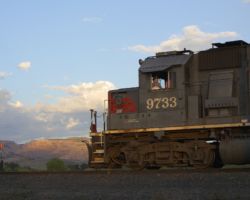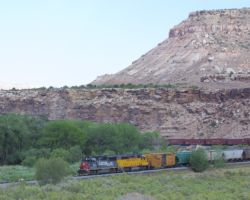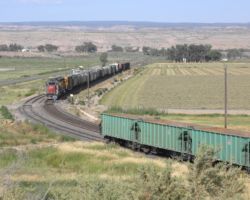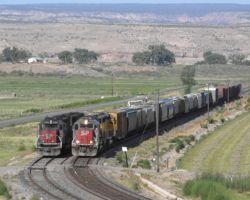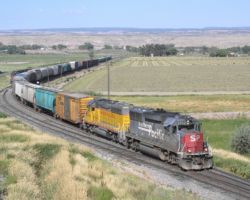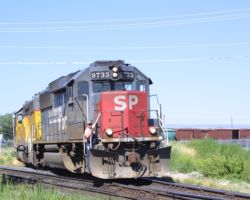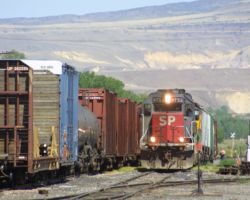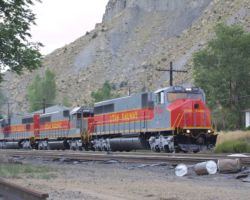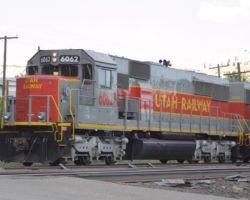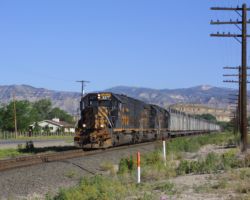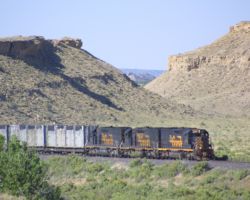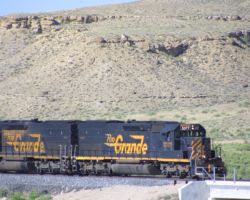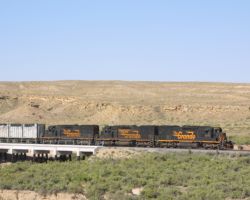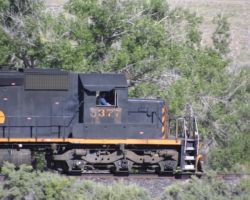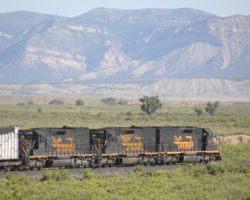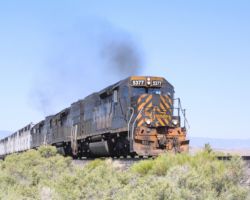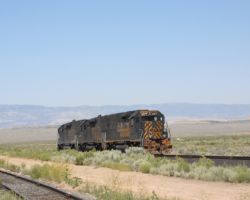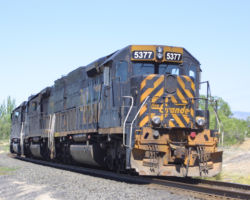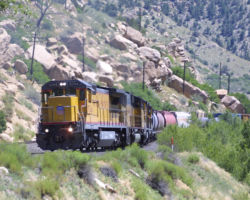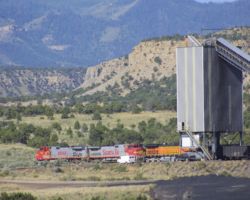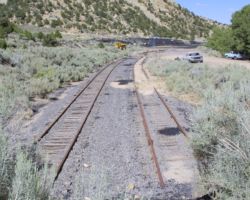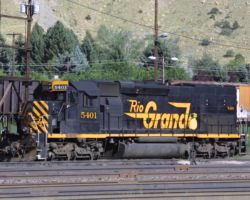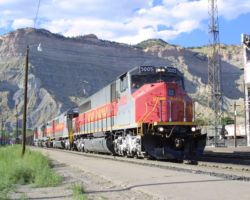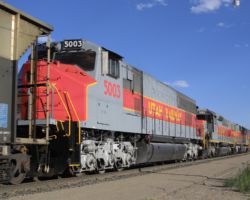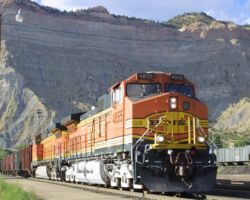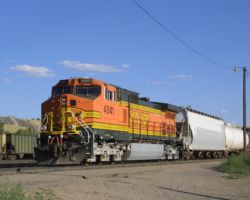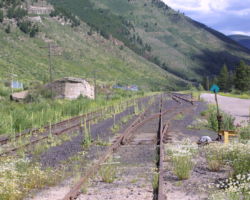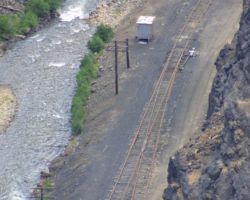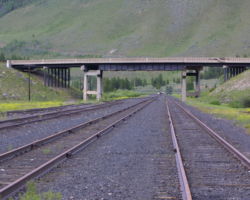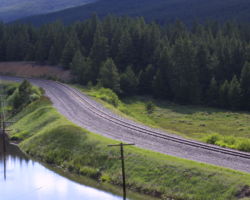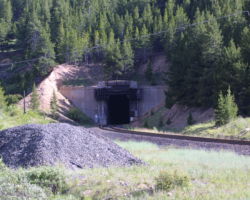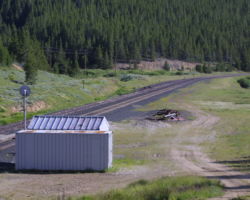The Montrose Local – July 20, 2001
Because the powers that be had decided I’d get Friday off due to them moving our offices to a new building north of Colorado Springs, I decided it would be an excellent time to head out to Grand Junction on Thursday night and catch some local traffic early Friday. From there, the plan was then to spend the rest of the weekend in Helper, as the D&RGW count was back up at four tunnel motors. At the moment, Grand Junction keeps a pair of Rio Grande GP40s, and I had some hopes these might be dispatched on the Montrose or Potash locals. Also, DRGW 5361 had arrived the day before, and there was always the possibility that it would get one of the locals.
For those unfamiliar with the territory, there are two weekly locals that run out of Grand Junction, CO. One runs south along the North Fork sub to Delta, CO, where it switches local industries and then continues south to Montrose along the original D&RGW mainline (back in the days when D&RGW was synonymous with three footers, but the line is now long since standard gauged). Typically, it seems to draw a pair of four-axle units for power. The other local runs west to Brendel, UT (also called Crescent Junction), where it turns south towards Moab on the Cane Creek Branch. It’s main purpose is to serve a mine at Potash, UT, just northwest of Moab, and hence is usually known as the Potash local. Typically, I’ve understood that this train draws several six-axle units for power, and hauls large cylindrical hoppers as its main cargo.
Friday started about 0500h, since I’d always heard that the locals were usually called for 0530h. Sure enough, despite hurrying to get everything together and checked out in time, I still heard the dispatcher talking to someone preparing the Montrose local for departure. I arrived in the yard almost right on time at 0530h, and there it sat – an SP GP60 on the front, and an ex-SP GP40 behind it, now in UP paint. Still being a few minutes before dawn, there was just barely adequate light to see that the cab was empty. Based on that, I decided to go look for the Potash local being assembled.
On the other side of the yard, up more towards the tower, I did indeed find something that looked about right – two six-axle units, a bunch of cylindrical hoppers, and a couple tank cars. This seemed reasonable, but the only problem was that it was going the wrong way. It appeared to have just arrived in Grand Junction, so I concluded that the turn had gone out far earlier than I expected and had returned before daylight. Darn – that left me with no choice but to follow the Montrose local, which hadn’t even drawn a DRGW unit.
As it turned out, even the Montrose local wasn’t ready to leave until nearly 0630h, so I did have the benefit of morning light before he pulled out. One of the greatest things about western Colorado and eastern Utah is how the surrounding mesas light up with a beautiful warm glow before the rest of the landscape in the mornings. As it just so happened, the local’s departure coincided with the very end of this phenomenon, and I was able to catch him leaving Grand Junction in some very nice lighting (Photo #1).
Being completely unfamiliar with the section of the line south of Grand Junction to Delta, aside from the fact I knew it was in a canyon to the west of the highway, I turned to my trusty DeLorme topo maps for a clue as to where to catch the train next. (And yes, for those of you who know me, I actually remembered to take all my gear this time, including both Colorado and Utah topo maps, Altamont Press timetable, scanner, camera, laptop, and, most importantly, lunch…) My best guess was Bridgeport, the second siding south of GJ (after Whitewater) and the first scenic place I really had access to the railway by road.
The line clings to the east side of the canyon at this point, making the lighting fairly bad southbounds in the morning. Also, just north of Bridgeport is the Bridgeport Tunnel, making southbound trains almost impossible to hear until just a minute or two before they appear. For reference, to get there one needs to turn west on 39 1/2 Road off of US Hwy 50, about twelve miles south of Grand Junction. There’s a parking area at the end of the road (right next to the west/north end of the siding), and my map shows the land on the east side of the tracks to be BLM land, meaning you probably won’t be trespassing if you get away from the parking lot.
As I was hiking north along the line, I heard the detector just south of Bridgeport go off, and actually detected some dragging equipment back near axle 340. Poor crew, I certainly wouldn’t want to walk that far down in this canyon – little biting bugs everywhere, and already getting hot by only 0730h. Still, by the conversation I gathered over the radio, I concluded that this was a northbound coal load off the North Fork, and he’d be meeting the local here at Bridgeport. With that, I further secured my position on the cliff above the west switch and waited… and sat, and let my rear go numb, and sat more, and waited… The only unnerving part was when I kept hearing gunshots from the ranch across the river. Couldn’t help but think of a mad rancher shootin’ at that there trespasser across the river (despite the fact I kept reconvincing myself I really was on BLM land…) Finally I heard the local’s power emerging from the tunnel, and managed to get Photo #2.
Just as I expected, the local’s crew stopped, threw the switch, and headed in the hole to wait on the westbound load. As it turns out, whatever was dragging was easily fixed and I didn’t have long to wait. Because of the little wash that the road follows down into the canyon, lighting is much, much better for southbounds. Soon, SP 170 emerged from around the corner (Photo #3), religned the switch, and continued north towards Grand Junction.
The next decent place to catch the local looked to be on the access road to Escalante Canyon, a few miles north of Roubideau. As I recall, the road is 6 1/2 Road, but is marked as 6.50 Road from US 50. A few miles down, it provides a nice view of a curve and straightaway, just before a grade crossing if you prefer a closer shot. (Photo #4) As I was getting back in the truck, I heard the local request a track warrant to work Delta, and the DS putting them in the hole at Roubideau instead to meet a work train.
9733 and the local arrived at Roubideau first, and stopped in the hole just short of a private crossing near the east end of the siding. Several minutes later, the detector up the line went off, and eventually a ballast car appeared from the cut, and then another, and another… (Photo #5) Quite a surprise for me, who had been setting up the shot assuming a locomotive would be in the lead. Apparently this particular work train had been dumping ballast around Delta, and was to dump some ballast further up the line towards Grand Junction. First, though, by what I heard on the radio it seemed some of the doors on the cars were stuck, and needed to be fixed before the train headed northwest. As soon as the work train was beside the local (Photo #6), the crewmember on the ground for the run-by climbed back into 9733 and once again we were off for Delta. (Photo #7). Photo #8 was taken of the work train sitting, apparently receiving maintenance to some of its dump doors.
Delta, Colorado, marks the junction between the now-busy North Fork line, which serves several large coal mines, and the original D&RGW mainline down towards Montrose. The line to Montrose, originally constructed as narrow gauge and passing through the Black Canyon, Marshall Pass, and the Royal Gorge all the way east to Pueblo, is reduced to a light industrial spur down to Montrose. Upon arrival in Delta, the first order of business for the local was to switch the grain elevator in the northwest part of town. This is done by cutting off the power and inbound cars (all on the head end of the train, leaving the rest of the train out on the line towards GJ), bringing them around the wye out on to the actual North Fork branch, and then switching them back into the elevator property (Photo #9). On Friday, there were about a dozen or so cars going in, and about four or five coming out. To get the cars all properly spotted took the crew nearly an hour, during which time I wandered over to McDonalds for something resembling breakfast – and, for a change, I didn’t even regret it this time, perhaps restoring my faith in fast food…
The yard in Delta definitely has an old Rio Grande feeling to it, especially with the light trackage and the wooden loading dock. After finishing a semi-lethal, but mighty tasty breakfast, I went down to the south end of the yard and sat to await the return of the local’s power. Sure enough, within fifteen minutes or so, 9733 and train returned to drag the rest of the train into the yard and switch the local lumberyard (Photo #10). After some time of watching the crew switch cars in and out, as well as rearrange bits of their train, it all became rather tedious and dull, and rather than wait for the train to proceed on towards Montrose I decided to head back into Grand Junction instead – and thus ended my first experience with the Montrose Local, unfortunately sans Rio Grandes.
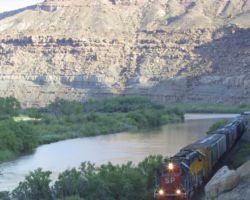
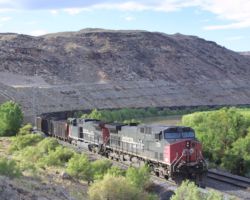
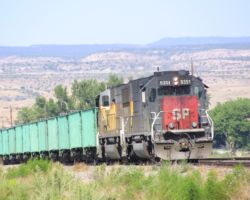
The Potash Local and On To Helper – July 20, 2001
After arriving back in Grand Junction, not much had changed. The two Rio Grande GP40s had moved a few hundred feet, but what was far more interesting was the fact that the tunnel motor was nowhere to be seen. For some reason, it never crossed my mind that it could have been sent out on the Potash Local, because I was still assuming that the Potash turn had already been run. Instead, I assumed it had gone east towards Lacy on that particular local. When I heard a detector go off at MP 433 and call a train with 12 axles (two units, suggesting the tunnel motor and the other UP thing I’d seen coupled to it), I jumped to the (dumb) conclusion that these must be the units I was looking for, and off I went.
Being light units, they were travelling east very quickly and I would always hear them calling the siding just ahead of where I was on I-70. Finally, to my relief I heard, “Low yellow, West Akin,” and minutes later I finally managed to catch them, just shy of DeBeque, CO. Imagine my disappointment, however, when instead of the D&RGW tunnel motor I’m expecting, I get two old UP SD40-2s. AAAAAA!!!!! ripping my own hair out Back to Grand Junction empty-handed…
Having no other reason to stay in GJ, it was off to Helper, UT, with the hopes I might catch a mid-afternoon local or some such running about with tunnel motors. Just west of Cisco, UT, I did manage to catch up with a westbound BNSF, and managed to get far enough ahead of it to photograph it at Brendel/Crescent Junction. (Photo #11) After the photo opportunity, I headed west once again, following 4747 and hoping to catch it again near Green River.
Nearing Solitude, a crackling message over the scanner changed everything. The dispatcher was asking DRGW 5361 on the Potash Local when he’d be back to Brende, in order to figure out when to give track and time to several track inspectors that were out and about. With the temperature on the truck reading 99 degrees, it made perfect sense that a level two heat advisory had just been issued between Durham (near GJ, CO) and Grassy (in Utah), and they wanted to be out actively checking for problems. 5361’s answer: 1500h. A quick look at my clock revealed it was currently 1425h, and I was approximately 20 minutes from Brendel. With the next exit, I was headed back east, cursing the whole way. So I hadn’t missed it that morning, it just went later than I was expecting.
For everyone else’s benefit, I now know that the Potash local is typically called from Grand Junction around 0730h, not 0530h like I’d thought.
When I arrived back at Brendel/Crescent Junction, there weren’t any headlights in sight. In a somewhat futile effort to get as many miles on him as possible, I headed down towards Moab. I only made about three miles, though, before some relatively quick-moving headlights appeared in the distance. Fortunately, being near a pull-off, I was able to get over, mount up the 300mm lens, and get ready to shoot. The only thing I hadn’t counted on, though, was the heat causing terrible distortions in the air over the desertscape around me.
No time to worry about heat distortions then, though – time to take as many frames as possible and sort them out when I got home. With a little loving care with Photoshop, Photo #12 came out better than I’d actually expected. At this point, the local was on fairly good track and moving along at a good clip, but with 65 MPH speed limits getting ahead wasn’t hard. Another mile or so back, Photo #13 came about. At that point, worrying about interchange traffic slowing me down, I decided to head back to the junction itself.
East from Brendel/Crescent Junction is the old road to Thompson – the highway (presumably US Route 6) before the interstate was built. This road is still passable, and affords an easy way to get better access to the ex-D&RGW main in these sections, since stopping alongside the freeway tends to be a bad idea. At Brendel, the Cane Creek Branch crosses the road at grade just north of the I-70 bridges, affording an easy shot as the local slowed to request permission to enter the main. (Photo #14) Once he was clear of the crossing but not yet out on the mainline, I wasted no time driving over to Thompson for a few shots of 5361 and train eastbound on the high iron, since once he was going he’d be almost impossible to catch except by freeway. Due to a bit of a delay in getting a signal, I had plenty of time to set up Photo #15. Nothing for this train was ideally-lit, but with such a rare thing as a Rio Grande on the Potash local, who’s complaining?
With a decent day behind me, I was looking forward to seeing more traffic on my way in towards Helper. However, it wasn’t to be. In the entire distance between Thompson and Helper, I caught but a single train – a westbound coal drag I’d seen earlier in the distance before turning around to go back for 5361. A very dead trip to say the least.
Upon arriving in Helper, I noticed that the clouds had started to roll in a bit, but the summit still looked clear. After checking that all four tunnel motors were indeed sitting in the yard, I started a quick little trip up the hill to Soldier Summit. Again, nothing most of the trip. Somewhere just below the summit, I caught up with BNSF 4747 west. Not terribly interesting, but not bad, either. Coming over the hill the other direction was another BNSF manifest, this one with three old green SD40-2s and a single BNSF warbonnet on it. In light of the road construction on the west side of the Summit, I thought it best to follow the eastbound down the hill back into Helper.
With the sun going in and out due to patchy clouds, choosing a location became rather difficult. Certain things would work if I had diffuse light, but if the full direct sun were to break out I’d be screwed. First, I settled on the bridge at Kyune, mainly because it was there and the cloud looked like it would stick around through the shot. (Photo #16) While I tried for shots at the Nolan tunnels, the long shot and low light made for a rather unsuccessful and blurry attempt. The only other shot back into Helper that was worth anything was at the crossing for the water treatment plant just north of Castle Gate. (Photo #17) Once back in Helper, though, I found other things of interest besides this BNSF manifest.
Sitting at the west end of the Helper Yards were three SP AC4400s, lead by SP 133 (Photo #18). Behind them was what I presume was an empty coal train (I failed to check), and a Utah crew could be heard on the radio bringing down helpers for it. Shortly after the BN passed, seven Utah units showed up from the west and presumably were cut onto the coal train in question (Photo #19). This group included two MK5000Cs (5001 and 5002), two old SD40-2s (9006 and 9011), and three ex-Hamersley Iron SD50s from Australia (6060, 6062, and 6063). I’m not exactly sure where all this horsepower was taking this train, but presumably it was going up onto the Utah Railway at Utah Junction and then on up to a coal mine to load. Surely with all this power it was going beyond Wildcat, though… I never did find out, because the light was failing and I was ready to get back to the hotel at this point. Yes, I know I’m a lazy, pathetic railfan. A true foamer would have followed it clear to the loadout…
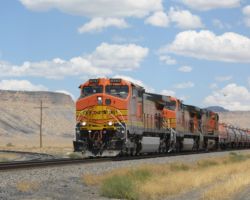
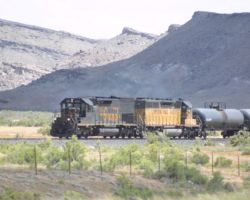
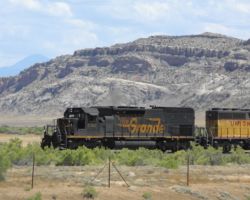
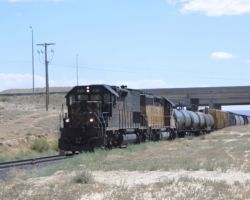
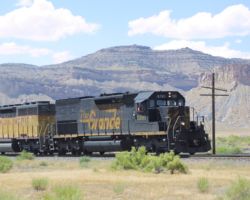
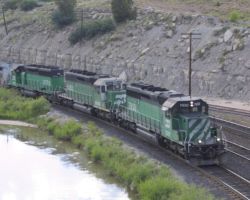
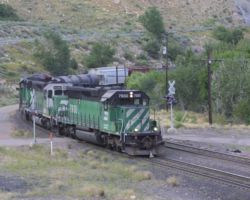
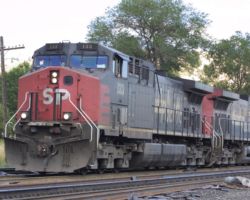
Three T-2s and a Dirt Train – Saturday, July 21, 2001
For those who don’t follow such things, Saturday, 21-July-2001, was CTC Board Magazine’s Day in North America 2001. The purpose is to “to illustrate North American railroading on a typical day in 2001.” Okay, so solid sets of Rio Grande power aren’t typical any longer, but the dirt train itself certainly is quite a regular (running trash from Salt Lake to Sunnyside, UT, six days a week, Monday-Saturday) and the area around Helper/Price is certainly one of my favorite locations. Since this was a short weekend trip, I’d only get one shot at the dirt train – Saturday morning.
I think I actually woke up sometime around 0730h, but true to usual style slapped the snooze button more than a few times. By now you all know I’m not a morning person, at all… Still, I thought I’d have more than enough time to get to Helper before the Dirt Train actually got together and headed south. By some dumb luck, I turned the scanner on before hitting the snooze button one time, and thankfully so. Within a few minutes, I heard the dispatcher indicate to DRGW 5377 that he’d be following Amtrak’s #6 (the eastbound Zephyr) out of Helper. Yikes!
With the world’s fastest shower/dressing behind me, and a donut I grabbed from the complimentary breakfast in my hand, it was in the truck and off towards Helper by 0830h. Not taking any chances, since the railway speed limit down to Wellington is reasonably high (60 most of the way, I believe), I followed the line north out of Price towards Maxwell on what I believe is known as Carbonville Road. Not a few minutes out of town, headlights appeared around the corner, followed by an endless string of grey containers on flats. Just so happened to be a crossing only a few hundred feet in front of me, so needless to say I took the opportunity to get on the right side for the morning sun. (Photo #21)
With such high track speeds between Helper and Wellington, there’s almost no chance of catching up with the train again before at least Mounds, where the Sunnyside Branch meets up with the mainline. There are actually two approaches in getting to Mounds. The first (and best for beating the train to Mounds, IMHO) is the obvious one – take US Hwy 6 from Wellington down past Sunnyside Jct. and over the bridge for the branch. In about another 1.5-1.7 miles, there’s a turnoff to the right that gives you a pair of roads – one forking left, one forking right. Take the right fork, and it will lead you right down to Mounds. The second option is to take a right at the east end of Wellington on Ridge/Farnham Roads, and follow Farnham down to Mounds. Both options are dirt roads, but at least with the first you get the benefits of ten or so miles of 65 MPH on highway before you have to hit the surface roads. The first will get you there faster, but the second will offer a great deal of interesting scenery on the way. I sincerely doubt you’ll beat him to the Mounds switch using either route (and driving safely, of course) – I certainly didn’t. I was about 3/4 of the way down the road when I saw the three tunnel motors coming around a curve, so I quickly turned around and headed back up to a shot I’d picked earlier. Fortunately, with the low speed limits on the branch (10-20 MPH), getting ahead and setting up shots is a very easy process.
The location I’d spotted was really a pretty easy catch – the road coming down from US 6 descends a long hill where several miles of the branch can be seen, including a steel/concrete trestle over the the same road some ways down. Let’s just say that with a 300mm lens (which, combined with the D30, is the equivalent of a 480ish-millimeter lens), a tripod, and the cool morning air (avoiding the heat wave problems from yesterday), a great variety of shots are available from this vantage point. I’ll just let the photos do the talking (Photos #22, 23, 24, 25, 26)
While the branch closely parallels the road to Sunnyside, there aren’t very many places to get a vehicle (especially one the size of my truck) safely off the road to get a shot or two. I did manage to find a suitable place this time, and as a result Photo #27 was created. After that, it was the usual run up to the road (and grade crossing) at the west end of ECDC’s landfill facility to photograph the train (Photo #29). Here I met another railfan, an electrician with the UP, who was also out for Day in North America and was following the three Rio Grandes. We spoke for about half an hour about various bits, and he eventually left for other places. I stuck around for a few additional minutes, and was rewarded with the returning light power (Photo #29). I thought it rather unusual they didn’t take any empties out, but then again I didn’t see any empties to take. Perhaps on Friday they’d done a double turn or some such.
After that, it was back to Helper, with a quick stop in Wellington to once again catch the three light units. It didn’t take long – within minutes of setting up at a crossing near the northwest end of town, the three cleared the west switch and came speeding through town (track speed is 60/79 – Photo #30). Also, a word to railfans – the Wellington police like to enforce their speed limit. I don’t think I ever went through town on this trip without seeing either someone pulled over or an officer running a speed trap. Just a helpful hint…
Saturday Afternoon Around Helper – July 21, 2001
After the local’s power had returned to Helper, a quick survey of the current situation revealed a westbound DPU-powered coal train preparing to go up the hill, along with reports that the MDVRO was in Wellington and headed west. The dispatcher made some comment about no westbounds between Grand Junction and Wellington to a track inspector, and he also mentioned that as soon as the ZRODV was out of the way, he’d cross MDVRO around the coal train and send them both up to the Summit. As a note, the ZRODV was apparently just passing Kyune, so it wouldn’t be much of a wait. Wanting to be near the center of all the action (and somewhere that was getting decent light, as it was just after 1230h), I headed for the pulloff up by Utah Railway Junction (just north of Helper).
While I was waiting on the Z to show up, the DS tried to bring the westbound coal up to the junction, but it stalled out about a mile short due to the DPU power not loading correctly. The plan was now to wait for the Z to pass, and MDVRO would pull up and check out the DPU units. Ah ha! If sheer willpower could only make units continue to fail – I can’t tell you how much I was hoping they’d both be horribly damaged, requiring a helper crew and a shove from a certain set of helpers sitting back in the yard…
As I was doing my wishful thinking, I heard the crew of the Z blow for the Castle Gate crossings, so I picked up the camera and snapped off a few as the train came into view – powered by coal train power – two GE ACs and an SD9043MAC! (Photo #31) I later learned that Friday’s westbound Z had stuck a hay rake at Silt, CO, causing minor damage to the leading SD70M, and this power had been quickly put on at Grand Junction in replacement. Apparently it was turned and sent back on the eastbound Z for Saturday, and perhaps would be changed out again in GJ or Denver?
Now it was a matter of waiting for the manifest to pull up beside the coal drag and hopefully pronounce its distributed power unusable so we’d get to see a few tunnel motors in action. Unfortunately, after about five minutes of radio chatter and inspecting the trailing units, the problem was found to be a disconnected MU cable between the first and second unit. With that plugged back in, things were fine and dandy again. Oh well, I guess I just didn’t wish hard enough… *grin* Even with the additional power, though, the MDVRO was still the first through. Since the light and angle weren’t very good for westbounds from my location, I decided to press on up the hill in search of better light.
About halfway from Castle Gate up to Nolan, I found my answer – a pullout and a decent shot of the tracks going through a nice curve. With a big enough zoom and a tripod, I thought it might work out nicely – or be absolutely lousy, but I couldn’t really tell without a train being there. So, I pulled out the tripod, set everything up, and waited, assuming the first train would be on the westbound main. Wrong…
After running around the coal drag, it turns out that the dispatcher didn’t cross the MDVRO back onto the correct main yet. Consequently, I was suddenly looking at a UP Dash-8 on the opposite track from what I’d expected. Quickly recomposing the shot and trying to get the exposure right, I think I managed with Photo #32. With that behind me, my next goal was to get a few shots of the train at Kyune, since I was guessing the lighting would be close to right.
From the highway, far above the railway at Kyune, there’s the possibility of getting a shot of a train snaking down through the canyon along the Price River. Unfortunately I’d never gotten the train and the lighting to work out on previous trips, but I had a good feeling it would this time. The train was soon there as well, and while the results aren’t ideal, I’m very happy with them. (Photo #33) I think a bit later in the day would work better, however – perhaps get a bit more light on the fronts of the units.
I made several attempts to photograph the coal train from earlier on its trip up the hill, but met with very little luck. The clouds just weren’t cooperating, and would regularly shade the sun at the very instant the train came into view. Or, worse yet, the line between sun and shade would fall right across the shot, rendering the whole thing impossible to expose correctly. Most frustrating, but it was only a coal train. At that point, knowing there were no more westbounds coming, and also knowing that the DS was handing out track and time like candy on Halloween on the west side of the summit, I decided to go take a quick nap to compensate for my rather abrupt wakeup that morning.
About 1400h or so I headed back out on the road, but hearing nothing on the scanner through my entire nap (I left it on so it would wake me up if something happened) I thought I’d go explore the Utah Railway instead. Beyond the joint trackage over Soldier Summit and the Utah trains operating off it, I’d never explored the Utah to the south and west of Martin/Helper. It seems there are four major and easily-accessible points on the line – Wildcat (Photo #33 – the loadout just southwest of Helper on Utah 139), Wattis (off Wattis Road, from Utah 122), Hiawatha (at the west end of Utah 122), and Mohrland (the end of the line, south from Hiawatha on some gravel road). I knew Wildcat was loading trains, but wanted to go check out the others.
To make it short: an interesting trip from a “where does that go?” perspective, but not much chances of catching operations out here. The tracks looked used as far as the Wattis loadout (a giant loadout silo on the side of a rather steep mountain), and there are a few (non-coal) cars at Hiawatha, but Mohrland hasn’t seen anything in a while. Either way, the line isn’t terribly accessible at any of these points – any railfanning would almost certainly involve some hiking, if of course there were trains. The hearsay I heard later was that only Wildcat is being used, but the shine on the rails at Wattis suggests otherwise to me. I could be wrong… Nonetheless, just to satisfy the curiousity of others, I’ve included a shot of the very end of the line in Mohrland. There’s a conveyor-belt type loader here, but I don’t think it’s loaded anything lately. (Photo #34)
Earlier in the day, I’d noticed a new blue VW Beetle sitting in Helper, apparently belonging to a railfan. When I arrived back in Helper around 1600h, the Beetle and another car were pulled up to the Amtrak platform on the west side of the Helper yard, and several railfans were about. I guess there’s nothing like the magnetism of a shining D&RGW tunnel motor to attract camera-toting railfans… (Photo #35) After a few moments of deciding just how anti-social I really felt, I pulled up as well and got out. As it turns out, the owner of the Bug was none other than Jim Belmont, a name I knew from the D&RGW List but had never met. Of the other two railfans (forgive me, both of your names are escaping me right now because I didn’t think to write them down – I’ll add them in if you happen to see this and remind me…), one was a friend of Jim’s and had ridden down for the day with him, and the other was a college student from Salt Lake City. We all sat and hashed over the usual round of railfan subjects until eventually Jim and company decided to head back in light of the time. The third remaining guy and I stayed for a bit, discussing all sorts of stuff (rail-related stuff, camera stuff, work, etc…) until four Utah units showed up with an empty eastbound coal train, lead by MK5000C number 5005, and followed by 6061, 9010, and 5003. (Photo #36-37) Rather odd – Utahs leading an eastbound empty and not diverging at Utah Junction. As it turns out, the train was actually headed for the CV Spur out by Wellington – apparently the Utah has trackage rights to this mine for loading (thanks to Todd B. for pointing out that I’d left this detail out).
Only minutes behind the empty was a westbound BNSF manifest, lead by a nice, clean Heritage II GE unit. (Photo #38) The especially odd thing was that this manifest not only had power on the front, but also had a DPU GE tacked on the back! (Photo #39) This is apparently a new thing for BNSF on the ex-Grande, as I’ve never seen it and there was mention of it being a new strategy on the D&RGW list when I arrived back at home on Sunday night.
Things grew quiet at this point, with no further trains expected for some time. I headed back down to Wellington, hoping to explore the alternate route to Mounds, and also hoping to possibly see the westbound Zephyr out in the middle of the Utah desert. A note to anyone – the road actually runs from Wellington along the Rio Grande down until almost Cedar, exiting on to US Hwy 6 around milepost 265, I believe. In places, it’s narrow, rough, and there are definitely plenty of surprise corners and dips through dry washes. The road is probably passable by a 2WD sedan aside from one little bit at the south/east end where there’s a rather muddy splashthrough of what my maps show as Grassy Trail Creek, but I certainly wouldn’t attempt it in wet weather, not even with 4WD and a high clearance vehicle. I have a feeling many parts of the road turn to pure mud, and the dry washes could potentially get nasty. Still, there’s some outstanding shots down here, and more antelope than you’ll be able to count. A very fun drive, and recommended in dry weather. I never did get a train, though.
Sunday was equally uneventful. After waking up, checking out, checking Helper, and heading out, I tried this same back road again, with the same results – no trains. In fact, aside from seeing the MDVRO somewhere around Woodside, I didn’t see anything the entire way to Dotsero, and I even did the narrow nasty BLM road thing between Cisco and Westwater (really fun drive, but requires high clearance, perhaps a little 4WD in one splash-through, and good intestinal fortitude). At that point I decided to give up on finding any moving traffic, and went to have a look at the west side of Tennessee Pass instead. Such is the photo bits you’ll find in chapter five – a look at the west side of the Tennessee Pass line, from Minturn to the Pass, as of Sunday, 22-July-2001.
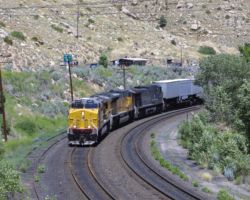
The State of Tennessee Pass – July 22, 2001
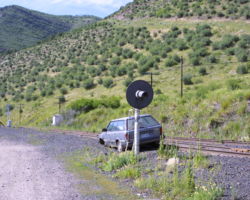
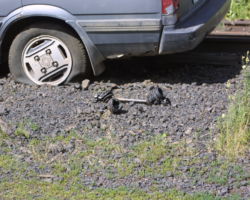
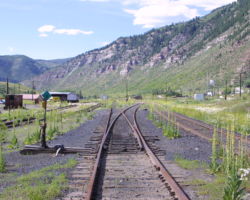
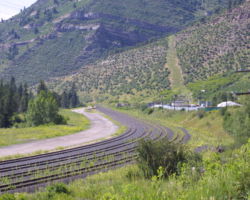
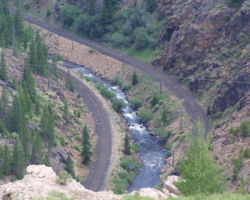
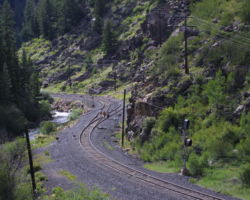
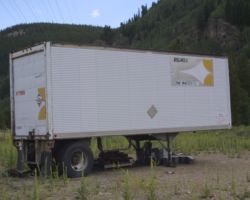
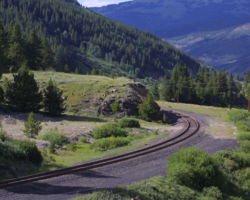
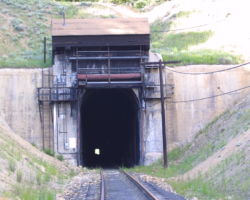
This work is copyright 2024 by Nathan D. Holmes, but all text and images are licensed and reusable under a Creative Commons Attribution-NonCommercial-ShareAlike license. Basically you’re welcome to use any of this as long as it’s not for commercial purposes, you credit me as the source, and you share any derivative works under the same license. I’d encourage others to consider similar licenses for their works.
